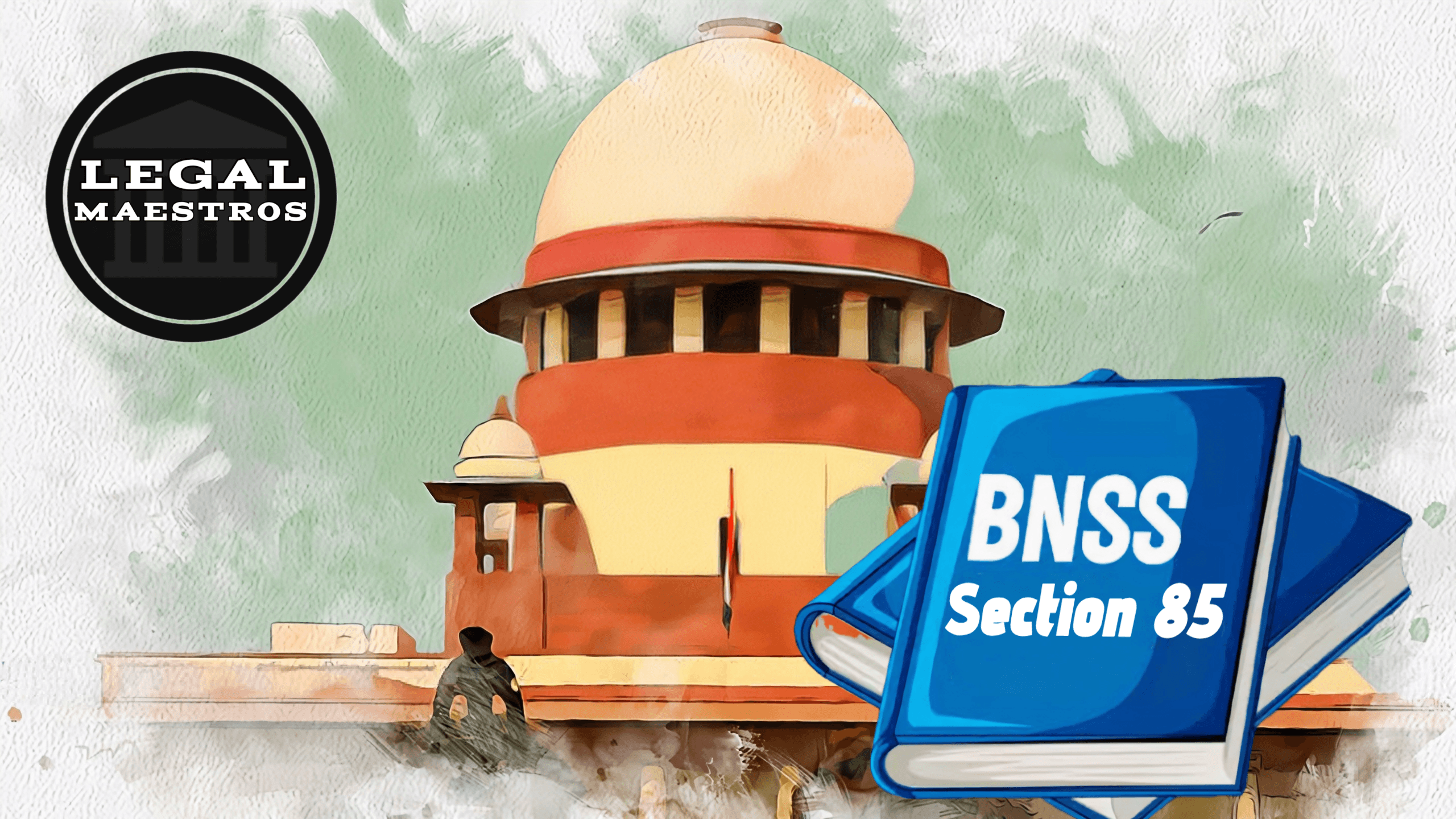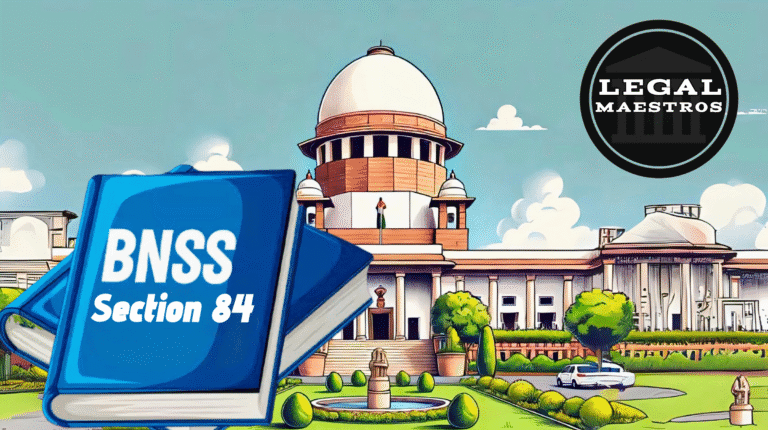
Section 85 of the Bharatiya Nagarik Suraksha Sanhita, 2023
One of the most important legal provisions, Section 85 of the Bharatiya Nagarik Suraksha Sanhita, 2023, is concerned with the attachment of the property of a person who has been declared an absconder in accordance with Section 84 of the same act. This part provides a legal framework to ensure that individuals who dodge justice do not get to enjoy their property or evade the repercussions of the legal system by removing or selling their assets. This section also ensures that individuals don’t get to enjoy their property.
That the court has the authority to order the attachment of moveable and immovable property in certain circumstances in order to protect the interests of justice is granted to the court. This could be considered a preventative strategy as much as a punitive one.
Adding Attachments Following the Proclamation (Subsection 1)
The court has the authority to order the attachment of the proclaimed person’s property in accordance with Section 85(1) immediately after a proclamation has been made in accordance with Section 84. However, this is not a procedure that occurs automatically. To provide a written justification for the necessity of attachment, the court is required to record its reasons. Consequently, this guarantees that judicial decisions are both transparent and accountable.
By way of illustration, if Ravi is proclaimed an absconder by the court for failing to appear in a criminal trial, and the court has reasons to assume that Ravi is concealing his assets or escaping arrest, then the court may pass an order to attach his house and car, provided that it documents the reason in writing.
In accordance with the provision of subsection 1, simultaneous attachment with proclamation
The law acknowledges that there are situations in which a person may hastily relocate or sell property in order to avoid having it taken away from them. It is therefore possible for the court to order the attachment of property at the same time that it is making the proclamation if it is satisfied, even by an affidavit, that the person is about to dispose of or remove the property beyond its jurisdiction. This is because the proviso to subsection 1 authorizes the court to do so.
In order to avoid the aggravating circumstance in which the accused has already concealed or sold off assets before the law can take action, this preventive precaution is in place.
Consider the following scenario: the police present an affidavit claiming that Suresh, who is going to be declared, has already begun the process of transferring ownership of his land to his family. In order to put a halt to the sale, the court has the ability to simultaneously issue a proclamation and order the attachment of the land.
Section 2 of the Order Determines the Jurisdictional Scope of the Order
It is made clear in subsection 2 of Section 85 that an order for attachment might cover property that is located both within the district where the order is issued and outside of it. On the other hand, in the case of property that is located outside of the district that issued the order, the order needs to be approved by the District Magistrate of the district in which the property is situated.
Through the implementation of this procedural requirement, inter-district coordination is preserved, and jurisdictional overreach is avoided.
In the event that the declared individual possesses property in Delhi, but the court order is issued in Mumbai, the order must first be approved by the District Magistrate in Delhi before it can be carried out in Delhi.
Methods for Attaching Property That Can Be Moved (Subsection 3)
The court has numerous options accessible to it when the property that is to be attached is moveable, including the following:
Seizure is the process of unlawfully acquiring possession of the property.
Someone is appointed to handle the property until further instructions are issued. This is referred to as the appointment of a Receiver.
The act of issuing a formal order that prohibits the handover of the property to the absconder or his agents falls under the category of prohibition orders.
Combination: The court may also apply any two of the aforementioned procedures, or all of them together.
Through the utilization of this adaptable technique, the court is able to select the most efficient manner in accordance with the characteristics of the property.
An example of this would be if the person who ran away had a fancy car and some bank savings. In this scenario, the car could be seized, and a bank order could be obtained that would prevent the withdrawal of funding.
4 Methods for Attaching Immovable Property to a Building or Other Structure
In the case of immovable property, the procedures differ according on whether or not the land is a source of revenue for the state:
For land that is responsible for paying taxes to the state, the attachment process is carried out by the Collector of the district.
Other properties that are immovables:
Taking ownership of something
An appointment of a receiver
The issuance of prohibition orders which pertain to the transfer or rent
Making use of any two of the three approaches
This provides solid legal tools for other immovable assets and ensures that administrative coordination is maintained in the case of government land.
In the event that the person who has absconded owns a rental property, the court has the authority to take control of the property and provide renters with an order that requires them to pay rent to the court rather than to the person who has been declared.
Section 5: Special Provisions for Property That Is Subject to Perishable Conditions
In situations where the property in question is perishable, such as food grains, fruits, or cattle, if it is not dealt with promptly, it may lose its value or even perish on its own. Under subsection 5, the court has the authority to order the immediate sale of the property in question. After that, the funds from this sale are kept and used in accordance with the orders that the court will issue in the future.
There is a possibility that the court will order the sale of fifty goats if the property in question contains goats that are susceptible to disease and require daily upkeep. The court may also decide to retain the proceeds from the sale.
The Functions and Obligations of a Receiver (Section number 6)
The powers, duties, and liabilities of the receiver, if they are appointed to administer the property, will be identical to those that are outlined in the Code of Civil Procedure, 1908. The preservation of the property, responsible management of the property, and accountability to the court are all included in this task.
When it comes to the management of attached properties, this ensures that nothing is unclear or inconsistent.
In the event that a receiver is appointed for a factory that is owned by the absconder, it is the responsibility of the receiver to ensure that the factory continues to operate without any mismanagement until further judicial decisions are made.
For any queries or to publish an article or post on our platform, please email us at contact@legalmaestros.com.







